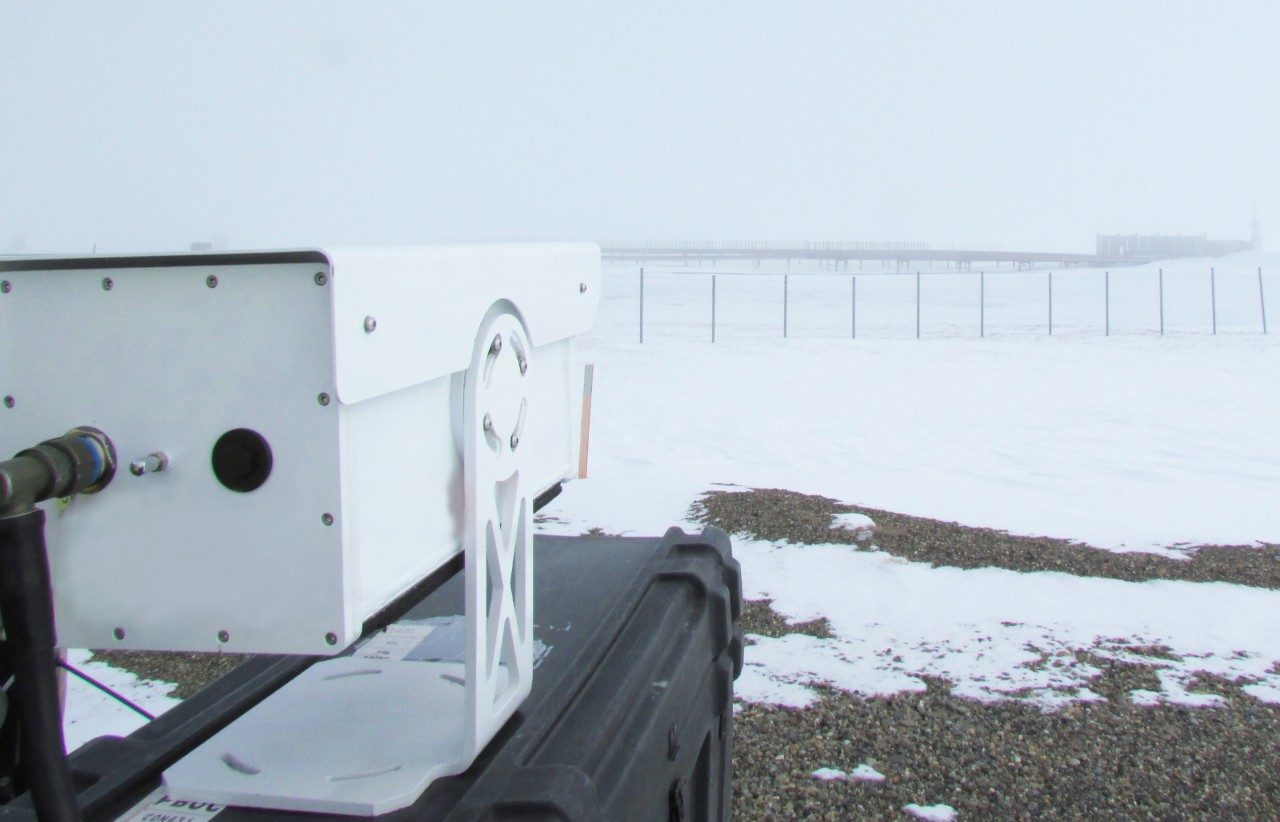BP operators using the VISR flare monitor camera to inspect flare stacks at a production facility in Angola, Africa. Photo courtesy of BP.
Lockheed Martin infrared sensors are the eyes that enable the most potent warbirds on the planet to see and detect threats. And today the same advanced technology protecting fighter pilots is helping energy providers like BP monitor hydrocarbon emissions at remote facilities around the globe.
Oil and gas facilities use flare stacks to safely burn excess hydrocarbon gases that can’t be recovered or recycled. During flaring, these gas emissions are converted into benign gases like carbon dioxide and water vapor. In spite of such efforts, some emissions do escape into the environment.
Enter the video imaging spectral radiometry (VISR) flare monitor, a game-changing camera that uses infrared images of the flare to identify and manage escaping gas. VISR is the first practical method of analyzing flare stack emissions in real time to ensure they are burning cleanly—and to properly combust 98 to 100 percent of emissions if they aren’t.
VISR Takes to the Field
VISR is manufactured by a three-company team of domain experts in the fields of IR sensor production and optical gas imaging. Lockheed Martin Santa Barbara Focalplane manufactures the multispectral infrared sensor, Surface Optics Corporation makes the camera and team lead Providence Photonics provides software that analyzes the IR imagery and optimizes flare performance.
After testing by the Petroleum Environmental Research Forum and the Environmental Protection Agency (EPA), the team was ready to send VISR into the field. Over a 12-month period, BP used VISR cameras to inspect flare performance at its facilities on Alaska’s North Slope and the coast of Angola. And BP is dispatching VISR to four additional sites this year.
“Inefficiencies in flaring is a potential source of methane entering the atmosphere,” said Peter Evans, BP Environmental Engineering Lead. “BP is determined to tackle such greenhouse gas emissions and help deliver a cleaner, better energy future. The VISR flare monitor enables us to do that, by helping us identify opportunities for real sustainable reductions in methane emissions.”
Using the VISR system to inspect multiple flare stacks at a site gives energy providers real-time performance data that can be used to minimize emissions by servicing or replacing those that are underperforming.

A VISR flare monitor at a production site on Alaska’s North Slope is helping BP evaluate the performance of upstream flare stacks.
Under the Infrared Hood
VISR leverages sensor technology developed by Lockheed Martin’s infrared center of excellence in Santa Barbara for advanced tactical fighters. It’s called a multispectral sensor because it can “see” in more than one spectrum, or band of light waves, at once.
Here’s how it works:
VISR’s infrared sensor captures 30 sets of flare images per second, each set consisting of multiple images of the same flare at the same moment. Nine images to be exact; one for each infrared band the multispectral sensor covers.
The camera correlates each of these nine images with a narrow spectral waveband that exposes the unique signatures of the gases remaining in the flare plume after combustion. By identifying these escaping gases, VISR determines how efficiently the flare is operating.
When installed as part of a closed-loop flare stack control system, VISR can optimize flare performance in real time. If a flare is not burning as cleanly as it should, operators or an automated system can adjust its operating conditions to get it back in the green.
Flare stacks abound in the oil and gas sectors, and there are many more in other industrial sectors. The EPA estimates that achieving a minimum destruction efficiency of 98 percent for U.S.-based oil refinery flare stacks alone will reduce hazardous air pollutants by 3,900 tons per year of and volatile organic compounds by 33,000 tons per year.
The VISR flare monitor enables operators to hit that 98 percent target every time—and even improve the performance of flares beyond the compliance requirements. During an EPA inspection of a downstream facility, the VISR flare monitor showed that the flare was operating above the required destruction efficiency of 98 percent.
Operators used VISR data to move that needle up to an incredible 99.5 percent — a 75 percent reduction in hydrocarbon emissions. Multiplying this result by the number of industrial flares in the world begins to show the potential VISR offers companies seeking to significantly reduce greenhouse gas emissions.




